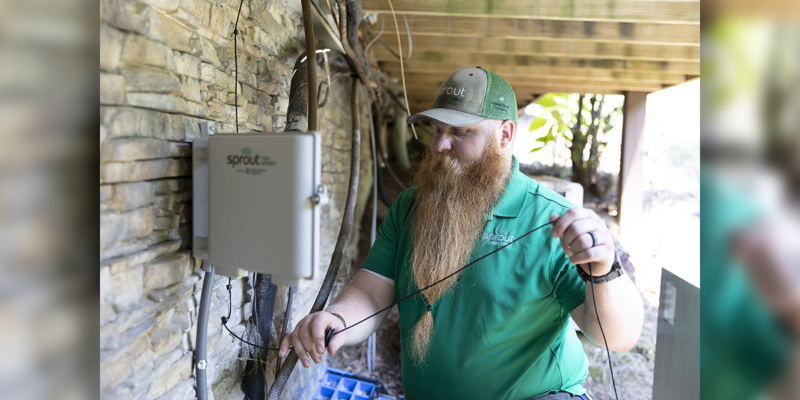CFC Helps Finance Alabama Broadband Project

A 2019 change in state law enabled Alabama-based Cullman Electric Cooperative (CEC) to create a broadband subsidiary that recently signed up its 9,000th subscriber. CFC has helped finance a large portion of the newly constructed fiber network.
Like many rural electric cooperatives, CEC knew that its members had few broadband options when it began to consider entering the telecom space.
“We knew that options for high-speed internet were very limited across a large portion of our service area, and those who did have options were choosing between services that were slow, unreliable and expensive,” CEC CEO Tim Culpepper said. “We had been doing informal surveys with our members at community events—asking their opinion on the most important issues for the future of our community—and high-speed internet service was the overwhelming top choice.”
But it was a change in state law allowing electricity providers to use existing and future easements to install broadband infrastructure that prompted CEC to take a serious look at offering broadband—and ultimately decide to launch its for-profit broadband subsidiary, Sprout Fiber Internet (Sprout), in June 2020.
“We wouldn’t be building a fiber system if the law hadn’t changed to allow electric cooperatives to use our existing poles to hang the fiber,” Culpepper said. “Because electric co-ops have that infrastructure in place already, that opened the door for co-ops in the state to take a serious look at taking on such a major project.”
Fiber Supports Electric System
Before deciding to launch Sprout, CEC’s board of trustees commissioned a feasibility study to give the board and senior management an idea of the financial and time investment required, and what results would be needed to make a fiber project successful.
Additionally, CEC’s approach to planning and preparation focused on how to select and implement the best technology for its purposes. CEC wanted to not only help its 48,000 members access high-speed broadband service, but also become a better power provider by leveraging the new fiber build for electric cooperative operations.
“From the beginning, we made it clear that our fiber project was not just about broadband internet service for members, but also a pathway to move our electric system forward,” Culpepper said.
Today, CEC has all 18 of its substations connected to a private, internally looped network that spans its entire system. Connecting the substations with fiber also allowed it to save significant cost on what it used to pay AT&T. The new network also gave the cooperative the bandwidth to install security cameras at every station, providing 24/7 visual access. Moving beyond the station, it now has over 50 downline devices connected to fiber providing data into its SCADA system.
“Long term, as we continue to build this out, it will give us the infrastructure to operate a fully functioning, system-wide, system-operator-based electric system,” Culpepper said. “We will be able to perform switching, emergency restorations in some cases, back-feed scenarios, load curtailment and daily system operations all from a central location in our dispatch office.”
The connectivity to these downline devices will also provide CEC instant access in different outage scenarios to analyze downline fault data and assist crews with getting to outages faster, which makes them more efficient, saving members money and increasing overall power reliability.
This year, mainline fiber construction passed the halfway mark, with more than 1,300 miles completed out of a planned total of 2,300 miles. The network is expected to be finished by mid-2026.
The initial focus has been on making broadband available to all parts of CEC’s service territory before looking at other areas. Today, Sprout has more than 8,200 subscribers, representing about a 40% take rate among CEC members who have access to the service.
“If we can maintain that rate as we finish construction to our entire service area, we anticipate having around 16,000 subscribers,” Culpepper said.
Another aspect of project planning involved looking for government grants to support network construction. So far, the project has secured $4.58 million from the state of Alabama’s Broadband Accessibility Fund and another $1.7 million from the USDA ReConnect Program.
These two funding sources were instrumental in developing its 2024 expansion plan, which will give another 7,000 CEC members access to gigabit-speed broadband service. “We are continuing to seek state and federal grant funding opportunities that make sense for Sprout and CEC,” Culpepper said.
CFC Funding Accelerates Project Build
CFC has helped fund a large part of the approximately $90 million project.
“CFC has been a tremendous help in rolling out the fiber project,” Culpepper said. “We have borrowed approximately $40 million from CFC that has been used for the design and implementation of Sprout, which has helped accelerate the timeframe of service. We will continue to work with CFC as we build our network and make broadband available to all of our electric members.”
For other electric cooperatives that may be considering offering broadband service, Culpepper recommended putting a high degree of focus on project planning, while rolling out service in a slow, methodical way.
Culpepper recommends performing exacting research upfront to understand the complexities of the telecom business, including talking to others in the business, listening to every comment and taking them into consideration. “Make sure you have a plan for every aspect: construction, make-ready, pricing, marketing, mapping, billing, accounting, funding, storm restoration, inventory management and procurement, maintenance, outages, customer service, compliance and safety. Plan, plan and plan some more, but then be prepared to make decisions quickly when surprises pop up, because they will,” he said.
He concluded his advice with, “Do not rush your initial launch. Turn up subscribers slowly and create processes while you learn what to do. Once you have the network and processes fine-tuned, then increase the number of installs you do per day. It’s a lot harder to go back if mistakes have been made and fix things.”